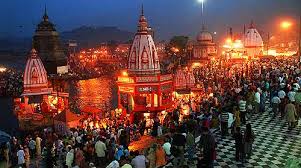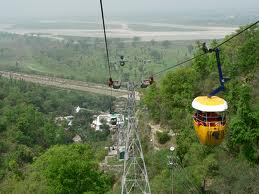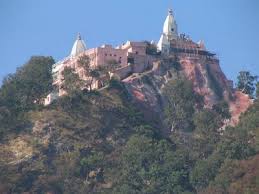|
The Haridwar city is also known as
the "Gateway to the Lord". The word Haridwar is combined of two
words 'Hari' stands for Lord and 'dwar' stands for gate. That is
why this sacred site is fam ous as "Gateway to the Lord". This
worthy place is located on the bank of sacred river Ganga. There
are many shrines, temples and ashrams to offer the prayer and for
pilgrimage. This is a hustling site with crowded markets. ous as "Gateway to the Lord". This
worthy place is located on the bank of sacred river Ganga. There
are many shrines, temples and ashrams to offer the prayer and for
pilgrimage. This is a hustling site with crowded markets.
Haridwar is the Gateway of Chardham yatra too. People from all
over the world visit the devoted site every year to perform the
Chardham yatra. The Chardham yatra adds Yamunotri, Gangotri,
Badrinath and Kedarnath the sacred destinations of devotion.
According to the Hindu mythology it is said that the religious
professionals named this holy site Haridwar. The city also very
popular for the well known fair Kumbh Mela that happening once
after every 12 years and Ardha Kumbh Mela after six years.
Countless people take a part in this Mela. Different types of
stalls and shops having religious aspects are the major
attractions for the pilgrims. At a distance of 10 kilometer there
is a 'Rajaji National Park" great for wild life lovers.
Attraction and Sightseeing
Har-Ki-Pauri
Har-Ki-Pauri is the sacred Ghat was constructed by King
Vikramaditya in memory of his brother Bhartrihari. It is believed
that Bhartihari eventually came to Haridwar to meditate by the
banks of the holy Ganga. When he died, his brother constructed the
Ghat in his name which later came to be known as Har-Ki-Pauri.
This sacred bathing ghat is also known as Brahmakund. The
reflection of golden hues of floral diyas in the river Ganga is
the most enchanting sight in the twilight throughout the Ganga
Arti Ceremony. It is the main ghat on the river Ganga, where a
holy dip is a must for every devotee.
Chandi Devi
Temple of Chandi Devi a top the Neel Parvat on the other bank of
river Ganga was build in 1929 AD by the King of Kashmir – Suchat
Singh.
 The temple is a 3 kilometer trek from Chandi Ghat. Legend
has it that Chanda-Munda the army chief of the local demon king,
Shumbha-Nishumbha, was killed by Goddess Chandi here after which
the place got the name Chandi Devi. It is believed that the main
statue was established by the Adi Sankaracharya in 8th Century AD.
Chandi Devi Temple is now accessible by a rope-way also, which
starts near Gauri Shanker Temple. The temple is a 3 kilometer trek from Chandi Ghat. Legend
has it that Chanda-Munda the army chief of the local demon king,
Shumbha-Nishumbha, was killed by Goddess Chandi here after which
the place got the name Chandi Devi. It is believed that the main
statue was established by the Adi Sankaracharya in 8th Century AD.
Chandi Devi Temple is now accessible by a rope-way also, which
starts near Gauri Shanker Temple.
Mansa Devi Temple
Mansa Devi temple is located atop the Shivalik Hills. Goddess
Mansa Devi, wife of the Nag King Vasuki, is believed to complete
the wishes of devotees visiting her temple. To
 look for the
blessings of the Goddess and get their wishes pleased, the
devotees tie sacred threads on the sacred tree that stands proud
in the temple premises. Once the wishes are fulfilled, the
devotees mark value by returning to the tree to untie the threads.
A charming view of Haridwar awaits those visiting this temple. look for the
blessings of the Goddess and get their wishes pleased, the
devotees tie sacred threads on the sacred tree that stands proud
in the temple premises. Once the wishes are fulfilled, the
devotees mark value by returning to the tree to untie the threads.
A charming view of Haridwar awaits those visiting this temple.
Maya Devi Temple
One of the Siddhapeeths of Haridwar and a vertex of the
Siddhapeeth triangle formed between Mansa Devi, Chandi Devi and
Maya Devi temples, this temple dates back to the 11th century. It
is believed that the heart and navel of Goddess Sati (first wife
of Lord Shiva) fell in the premises of this very old temple.
Goddess Maya Devi, the Adhisthatri deity of Haridwar, is
recognized to be an incarnation of power or shakti. A visit to
Haridwar is partial without seeking the blessings of Goddess Maya
Devi. Maya Devi temple is the 3rd very old temple of Haridwar
still intact, apart from Narayani Shila temple and Bhairav temple.
Bharat Mata Temple
Sited in Sapt Sarovar near ashram at Haridwar, Bharat Mata
Temple is a holy place of its own kind. Bharat Mata Mandir was
founded by Swami Satyamitranand Giri. On 15th May 1983, the temple
was instated by Late Prime Minister, Smt. Indira Gandhi. The
temple is also unique in the sense that it is built in 8 stories,
each of which represents a specific theme and is devoted to
various legends and deities of India. The eight-storey temple
rises up to a height of 180 ft.
Bhimgoda Kund
Bhimgoda Kund enlightens the travelers on the rich religious
heritage and mythological legacy of the bygone golden time. Legend
has it that while the Pandavas were here, Bhim with one blow of
his horse's hoof drew water from the rocks at this spot.
Daksha Mahadev Temple
Daksh Mahadev temple is situated at a distance of 6 km from
Haridwar. The very old temple of Daksh Mahadev is positioned in
the south of Kankhal town. This temple was constructed by Queen
Dhankaur in 1810 AD. Kankhal has several temples and ashrams. Most
important temple of Haridwar.
Kanva Rishi Ashram
Kanva Rishi Ashram to be found on the banks of the river Malini 42
kilometres from Haridwar is believed to have been the site of the
hermitage of Maharishi Kanva. Although not a Saptarishi, the sage
is generally believed to have authored some of the Vedic mantras.
He is more famous as the sage who raised Shankuntala Vishwamitra's
daughter and her son Bharata
Sapt Rishi Ashram
Soham Swami was a big spiritual leader and yogi of India. He was
in this world previous to the 1st part of the 20th century. His
actually name Shyamakanta Bandopaddhyaya. He was Advaita Vedantic
follower of Tibbetibaba. Tibbetibaba was a big yogi and maharishi
of India. Soham Swami built an ashram named as Soham Ashram in
both in Nainital and Haridwar. He was born at Autsahi in Dhaka.
Shantikunj
Shantikunj is the headquarters of the spiritual and social
organization All World Gayatri Pariwar. Recognized in 1971 at
Haridwar, it has emerged over the years as a center of the global
movement of Yug Nirman Yojana for moral-spiritual regeneration in
the light of hoary Indian heritage. Sited at the bank of holy
Ganges and between the Shivalik ranges of the Himalayas, it's also
a place of attraction for tourists and seekers of spiritual
guidance. |